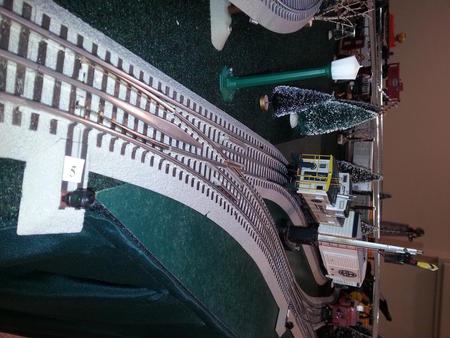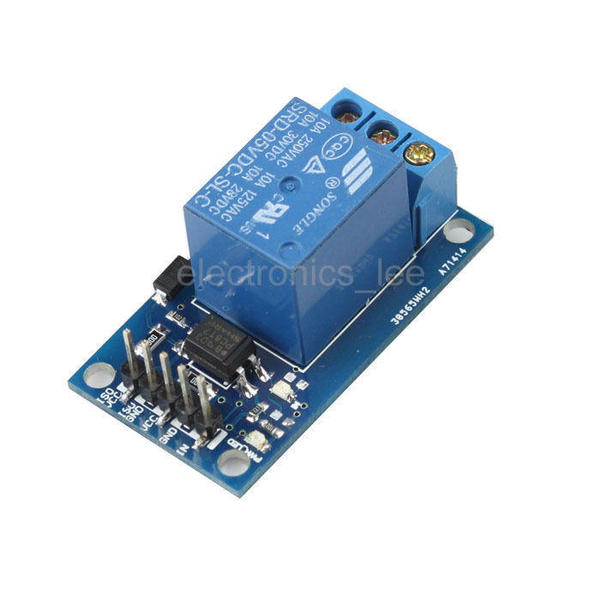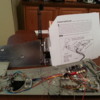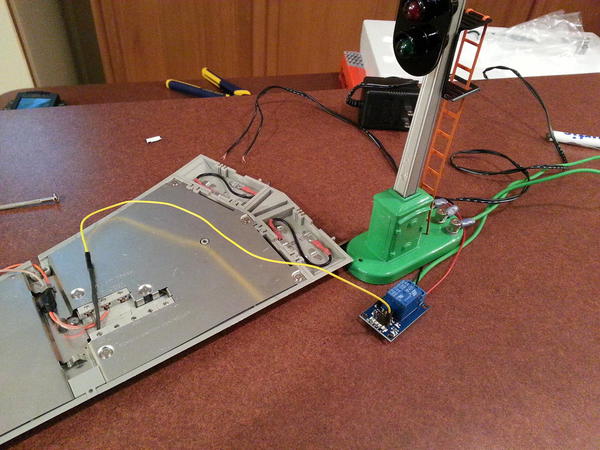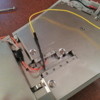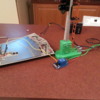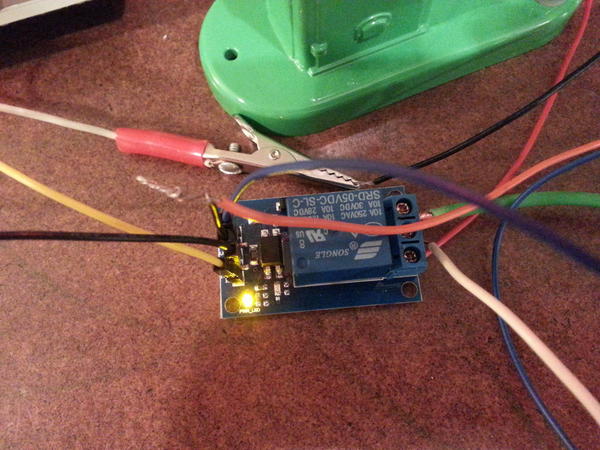Is it possible to take a Lionel 153C block signal(3 terminals) and wire it to Lionel Command control Fastrack switch? So when the switch is thrown in one direction or another, the block signal matches the green or red post on the switch. The end result is to see which direction the train will be destined to go from a distance (from your legacy remote). Perhaps another type of signal would work better (open to suggestions here). Thanks
Replies sorted oldest to newest
USCGRET,
Not sure if this is really possible, however I was thinking on using a street light in the same manner because the street light has just Hot & Ground wires, in this manner I will be able to see them from a distance on the layout. Curve street light lit, straight light out. I am use to seeing the old 711 switch lights and the new CC Fastrack switch lights are kind of small, for this old mans eye sight.
PCRR/Dave
The switch outputs to the lever controller light green and red LEDs. The signal voltages that do this are +5 vdc for green and -5 vdc for red. You could use them as signal levels to operate a relay to control the block signal.
I will give it a try and see if it works....I will let you all know.![]()
Well you will have to apply the change in voltage to some higher powered citcuit to operate the block signal. The block signal probably takes a half amp or more to operate. the LED drive signal is probably only capable of 20ma or so.
I'd use a diode and a transistor to drive a relay. The relay will handle the current to drive the signal.
USCGRET,
Let us know how you make out on this will ya, I am definitely interested.
PCRR/Dave
USCGRET,
Did you try cjacks suggestion, I am waiting for you to try it, before I wire mine up to our CC FasTrack switches, this could be real neat if it works.
PCRR/Dave
Dave,
I have not yet dove into this project. I'm still waiting on parts. I will advise.
Brian
If you simply wired up a signal with LED's, you could drive it directly from the position indication that comes from the switch, no relays or other stuff in the picture. The signal is a bi-polar 4 to 4.5 volts, so a 100 ohm resistor and a red and green LED wired back to back would do the trick. Return the other side of the LED's to track common.
Simple and cheap.
gunrunnerjohn,
What I want to do is connect the track signals like USCGRET has pictured, under my Command Control FasTrack switch, to activate the manual track signal arm, by using my remote control, when throwing my CC switches in either direction. Where exactly would I connect on both the CC FasTrack switch, and the old Lionel manual signal to make this work properly.
PCRR/Dave
The signal arms have a solenoid in them to move the arm. They take more than what the switch controller can supply. But if you use LED block signals with just lights, then you can avoid the relay and relay driving circuit.
If you want to order up some LED lights very inexpensively here is the sight on ebay.
For an old Lionel signal, you'll need to have a relay driver and relay from the Fastrack switch position indicator line. Once you have a relay indicating switch position, you can wire almost any accessory to it.
If you want to order up some LED lights very inexpensively here is the sight on ebay.
These won't work directly, as they have a common anode. You need to be able to wire the Red/Green LED's back-to-back to use the signal capability directly from the Fastrack switches.
Gunnerjohn,
So could you adapt these, and if so, what would you need? I do basic electronics. Thanks.
You have to get to the actual physical LED's to rewire them.
Gentlemen,
Nuts this is not what I wanted to hear, am I missing something is there no simple way to activate the signal arms and their small lights, when operating the low voltage switches for Command Control, with a remote. John with your electrical education there has to be some easy fix for this, of some kind.
PCRR/Dave
The signal from the Fastrack switch is a low-current bi-polar signal. The signals under discussion take far more current and voltage to operate. The issue is, turning the low voltage, low current Fastrack indicator signal into something you can use.
My method would probably be a couple of resistors, a transistor, and a signal relay. Now I have a set of isolated contacts that I can drive anything I desire from.
There are some Arduino compatible relays available on eBay for very cheap prices. They are TTL compatible inputs, I may dig one of those out and see if the Fastrack switches will trigger them. If so, that would be a nice turnkey solution to the issue.
gunrunnerjohn,
Please dig them out and see if they work, if so I will invest in a couple of the ones on e-bay.
Thanks again john for all your help
PCRR/Dave
Thanks for keeping this moving along. I took a look at some of the Arduino relays on ebay. John, if you can dig one out and trigger one of the fastrack switches... wow. Take a pic of the relay you used, so I (we) can purchase. The prices look right!
Thanks again...
The results are in. I suspect almost any of those modules will work. I tried one of the opto coupled ones and one of the non-isolated ones, both worked fine. I'd be pretty sure that almost any of the similar relays would work as well.
Here's the two channel one, it has opto-isolation: C:US:3160" target="_blank">2-chan opto-isolated Relay Module
Here's the four channel one, it is not isolated, just uses transistors to drive the relays: C:US:3160" target="_blank">4-chan Relay Module
You need to supply the relay module with regulated 5V, a cell phone wall-wart is perfect for this. Other than that, you just need a series diode with the cathode toward the Fastrack switch indicator lamp lead to block the negative voltage. The relay is closed for positive voltages and open for negative voltages. Since it's a single form-C contact (SPDT), you can drive a signal when it's open and when it's closed for the two states (colors).
Note: the 4-chan relay says Optocoupler, but they lie, there is no opto's on the board. ![]()
gunrunnerjohn,
This is great, it means I can purchase a single opto-relay for each Lionel signal and wire them at each switch location or purchase a double and run line to 2 of the Lionel signals, depending on the switch locations and how close they happen to be. This is going to be great, thanks again John for all your electrical knowledge! I take it that the remote control when activating the CC FasTrack switch will also activate the old Lionel direction signal via the opto-relay. That means I could also use the opto-relay for my old Tin Plate crossing lights, in the same manner. I will order about 4 doubles and 4 singles of these opto-relays for my Christmas FasTrack Layout. Way cool John.
If a guy wanted to he could use the 8 channel opto-relay but then it would lead to running wires all over the layout, which I am trying to eliminate. I do believe one of these opto-relays mounted at each old Lionel directional signal would immulate the Union Switch & Signal power station at the real crossings & switch locations, just like on the actual railroads. Real nice find john!
USCGRET,
Thanks for starting this thread I really appreciate it, big time. This means all my old Lionel signals will operate with my low voltage Command Control. Ya got to love this OGR forum!
PCRR/Dave
Given the nature of the electrical output and relay inputs, I'd have been surprised if it didn't work. However I figured I'd better test it before someone bought a raft of these relays and then found out there was a problem.
Don't want any angry train nuts storming the castle. ![]()
John,
That is Psyco train nuts thank you very much, words mean things.
I do beleive you are starting to get to know me, Gomez Adams was my favorite
train runner. Ofcourse I blow them up, why else would a grown man play with trains!
PCRR/Dave
John and Dave,
This is great. I will utilize all the insight. Thank you John for your electrical wisdom, and Dave for the help in driving this thing. Since I appear to be the novice here, I may have additional questions on my installs. The hobby is great, and learning something new each day is awesome. Regards,
Brian
John & Brian,
Just ordered 3 doubles and 6 single opto-relays from the sight John posted, with only $3.00 as a shipping promotional, the entire order cost less than $20.00. A great deal for being able to use my older Lionel higher voltage signals, with the low voltage CC FasTrack switches.
Thanks again John, and you too Brian for starting the thread.
PCRR/Dave
Don't forget the diodes. ![]()
Don't forget the diodes. ![]()
The diode is for? The signal comes from the yellow wire...and goes to the relay opto coupler...is the opto ok for minus 5? Does the opto just have an led as its input and not short the minus 5 so it will still light the red led?...I. Know that some of them have a reverse diode at the input. just wondering...have to look up what opto it uses.
John,
Please explain, I thought these units were stand alone, what diodes I must have missed something.
PCRR/Dave
In my original test results I said:
Other than that, you just need a series diode with the cathode toward the Fastrack switch indicator lamp lead to block the negative voltage. The relay is closed for positive voltages and open for negative voltages.
I observed some odd behavior without the diode, so it's included. For ten cents, it's probably a really good idea to include it. ![]()
John,
I thought all that was eliminated with the Opto-relay, my misunderstanding. Ok please give me an identification on these diodes # please, that I need to purchase and where do I purchase them from, and please explain where I install the diode on the
opto-relay wiring.
PCRR/Dave
You can use almost any silicon diode, cheap choices are 1N4001 through 1N4005, commonly available for less than ten cents in any kind of quantity.
The opo-isolation is only on one of the modules, and also the input LED for the opto has a reverse voltage specification, I didn't check what it was.
As far as where to install them, I thought I said that a couple of times.
you just need a series diode with the cathode toward the Fastrack switch indicator lamp lead to block the negative voltage.
The cathode is the banded end of the diode.
In my original test results I said:
Other than that, you just need a series diode with the cathode toward the Fastrack switch indicator lamp lead to block the negative voltage. The relay is closed for positive voltages and open for negative voltages.
I observed some odd behavior without the diode, so it's included. For ten cents, it's probably a really good idea to include it. ![]()
I finally found a schematic of these relay units, the ones with the opto chip installed and the tiny LED in series with the input circuit.
There are two ways to operate the relay.
1. leave the jumper installed which connects Vcc and JDVcc. In this case supply +5Vdc to Vcc on the input pin(s) connector and Ground to the GND pin. The selected relay will then operate by grounding the input pin for that relay...and the tiny LED will light (very useful, that feature).
2. move the jumper to connect GND and Vcc. In this configuration again connect +5Vdc, but to the JDVcc pin which is now available and again Ground to the GND pin on the input connector area. Now the selected relay will operate when -5Vdc is applied to the input pin for that relay...and the LED will light, etc.
The input circuit is Vcc to a resistor, thru the opto input led diode, thru the tiny external LED and to the input pin. So when using method #2 which is compatible with the yellow wire signal from the FasTrack switch, there are two diode reverse voltages to protect the circuit from when the yellow wire goes to +5. The opto input is good for 6 volts reverse and then the external LED is probably good for about the same. So I think the whole thing is ok without an external diode, but it's a good practice to use one. The 1N4004 is a cheap choice and you can probably get them at Radio Shack. As John said, put the cathode of the diode toward the yellow wire source.
Attachments
cjack,
When the opto-relays get here, I will wire them as per your #2 instructions and see what happens, I was hoping these were stand alone relays. Thanks much for your help
on figuring this out.
John,
Sorry you had to repeat your instructions, remember I have had no training in Electrical engineering, learning this on the fly, sometimes I misunderstand what is said.
PCRR/Dave
AND to clarify a little, with #2 hookup, the relay will be operate when the FasTrack switch controller shows RED.
cjack,
I do not remember if the hand held remote Control makes the hard wired remote, change lights or not, when I operate the Command Control switch from the wireless hand held remote control, it probably does.
PCRR/Dave
cjack,
I do not remember if the hand held remote Control makes the hard wired remote, change lights or not, when I operate the Command Control switch from the wireless hand held remote control, it probably does.
PCRR/Dave
It has to. Anything else would be unconscionable ![]()
When you rotate the lantern, the controller changes color...
Dave,
I like your idea about ordering singles and doubles. Which ones did you go with? Can you send me a link? Thanks, Brian
USCGRET,
Brian, John already posted the link in one of his prior posts, click on the 1st one he posted, scroll down, you will see a row of them, I picked one of the doubles and one of the singles, and just inserted the number of each that I wanted, and payed for them right on that web page. Sale Conformation by e-mail. Simple as that. I will follow cjacks #2 instructions that he posted for setting them up, with our old Lionel track indicators. Looks like it should work.
PCRR/Dave
Note that some of these are not opto-isolated, so I still suggest the diode.
john,
How do you know which are isolated, I thought the ones you posted all were? The 2 different opto-relays that I purchased seem to have the diodes already in them, if I know what I am looking at. Now the single opto-relays are all gone, I bought the last of them, no big deal however, just purchase the double.
Brian just so you know I bought #2 in the picture and the singles were #4, but have changed to another double now.
PCRR/Dave
Look at the pictures...the opto ones have the little 4 terminal opto chip clearly on the board, the non-opto ones don't.
Here are pictures of both...and the schematic of the non-opto. Actually the non-opto doesn't need a diode for reverse voltage protection, but looks to need one to insure that the transistor driver does not partially turn on if the +5 from the yellow wire is less than the +5 applied to Vcc for relay power. I checked a bunch of my Command Switches, and they were all between 4.9 and 5.1 Vdc...so that would be safe without a diode, but the extra 0.7 volt diode drop would be welcome to make sure the transistor is off when the yellow wire signal is +5Vdc, the green state.
Attachments
BTW John, thanks for this great idea. I actually had some of these from an Arduino project, but never thought to apply them to the FasTrack switches. Great idea.
cjack,
The single opto-relay you posted, I believe is the opto-relay that I purchased 4 of, ordered an addition 4 from the post you recommended also, the doubles in the prior post, I also purchased 3 of, guess I was just lucky with my choices. Thanks much for your detail in your #2 wiring instruction, much appreciated. One other explanation needing further detail for me, the 5V wall-wart, John talked about, how and where do I connect it to the opto-relay for powering it, I take it I will need to either splice and run it to every opto-relay location or have a plug type wall-wart unit for every opto-relay for powering them individually. Could I get way with using a MTH small terminal block, using it for a wall-wart power line splitter, running to numerous opto-relays.
John thanks again for your engineering knowledge on all this, great stuff.
PCRR/Dave
The relay modules require 5VDC for operation. You can obtain that by rectifying track power with a diode, capacitor, and a regulator. You can also get it from simply chopping the connector off a regulated 5V wall wart, the ones for old phones are frequently a good choice. The 5V goes between the VCC and GND connections on the relay module. One wall wart will probably power a bunch of these modules.
Here are the specs on the relay itself (not easy to find, but these seem the most accurate):
- Songle SRD-05VDC-SL-C Relay
- Relay UL/CUL Rating: 10A @ 125V AC, 28V DC
- Relay CCC/TUV Raiting: 10A @ 250V AC, 30V DC
- Control high-power devices up to 10A with a simple high/low signal
- Provides isolation between the microcontroller and the device being controlled
- Screw terminals for relay connections
- 3-pin servo-style header for power/signal interface
- LED indicator provides visual feedback
- Voltage requirements: 5V DC (Relay Power), 3.3V to 5V DC (Input Signal)
- Current requirements: ~85 mA (Relay Power)
- Communication: Logic High/Low (3.3V to 5V DC)
- Dimensions: 1.57 × 1.06 × 0.71 inches (4.0 × 2.7 × 1.8 cm)
- Operating temperature: -13 to +158 °F (-25 to +70 °C)
So that says about 85ma per relay.
Safely, if you have a one amp wall wart, you could run about 11 relays on at one time.
Just make sure the wall wart is a regulated 5V type. ![]()
There are indeed connectors you can use, these are standard .1" spacing posts.
John,
Thanks again when I get this all together, some time I will post pictures.
I appreciate all your Technical help big time.
Thank you also cjack for all your help also, learned a lot from this particular thread.
Brian,
Hope you got all this technical info so you can use your old Lionel equipment with your FasTrack switches also. Thanks again for starting this thread.
PCRR/Dave
We look forward to seeing the signals operating. ![]()
Those are useful, I have about a dozen in my parts box, and I occasionally use them in projects.
Here's an idea for wires with single sockets to plug into the relay modules...
Cjack,
I ordered the connector socket line and stayed with John & your original opto-relays, thanks for making this so simple with providing the lines. When all shipments have arrived, I should have this all together for next years Christmas layout. John I have 2 of the old home cell phone power line charging units set aside for powering the opto-relays as you suggested, great idea.
PCRR/Dave
cjack,
When the opto-relays get here, I will wire them as per your #2 instructions and see what happens, I was hoping these were stand alone relays. Thanks much for your help
on figuring this out.
John,
Sorry you had to repeat your instructions, remember I have had no training in Electrical engineering, learning this on the fly, sometimes I misunderstand what is said.
PCRR/Dave
Hi Dave,
Did you ever get your switches wired up to your lights? I'm about to dive into this and wanted to know what works. Would love to see a pic of the final result. Thanks,
Brian
If you simply wired up a signal with LED's, you could drive it directly from the position indication that comes from the switch, no relays or other stuff in the picture. The signal is a bi-polar 4 to 4.5 volts, so a 100 ohm resistor and a red and green LED wired back to back would do the trick. Return the other side of the LED's to track common.
Simple and cheap.
Hi John,
I could use some of your help here. I want to wire a simple LED light signal (red & green) to mimic my CC Fastrack switch. Your earlier note stated that you could simply wire it up from the position indication on the switch. Since we have gone back and forth on the subject, I should not need a relay for the LED light. I have re-read your portion on just wiring up a simple LED and cannot get it to work. I took apart the switch (see picture) and have included the LED light I am going to use. The signal has a green, red and black wire(with a resistor attached) but just cannot not figure out where to wire them in(See pic). I thought I got close a couple of times but the switch would not work properly (seemed like it was power deprived). Notice the remote cable is removed. I thought mabe I could wire up to the YRBG slots for the light to work. That's not the answer. Perhaps some guidance from you. New to the hobby, but want to learn. I got several hours into what I thought was simple. Thanks.
Attachments
You need a red/green 2-wire bipolar LED and a 270 ohm resistor. Wire them between the GND and RSC LIGHTS pins on a Fastrack switch and it'll change colors with the position. If they're reversed in sense, swap the leads to the LED.
I just did this on my bench to make sure there was no issue, works great and senses the switch position from manual, remote, or even the command from the TMCC/Legacy remote.
You need a red/green 2-wire bipolar LED and a 270 ohm resistor. Wire them between the GND and RSC LIGHTS pins on a Fastrack switch and it'll change colors with the position. If they're reversed in sense, swap the leads to the LED.
I just did this on my bench to make sure there was no issue, works great and senses the switch position from manual, remote, or even the command from the TMCC/Legacy remote.
So the LED signal light I have will not work because it has 3 wires (Red - Green- and black with a resistor?
Correct, you the polarity of the lamp signal reverses based on switch position, a 2-wire LED is the ticket to simply create this indicator. You can probably kludge a 3-wire to do it, but it'll take other components and is clearly not the simple way to do the job.
Correct, you the polarity of the lamp signal reverses based on switch position, a 2-wire LED is the ticket to simply create this indicator. You can probably kludge a 3-wire to do it, but it'll take other components and is clearly not the simple way to do the job.
John,
Do you have a link to where I can purchase the bi-polar LED Signal/Light?
LED-Switch, about 2/3 of the way down the page. If you want 2mm or 3mm, they have them in that size as well.
Attachments
LED-Switch, about 2/3 of the way down the page. If you want 2mm or 3mm, they have them in that size as well.
Thanks John,
I have some of those, but was hoping for the actual signals, with the bipolar lights already built in. Hopefully similar to the one in the pic I sent you. I don't think I'm up for rebuilding/modifying the signals I have, since they are so small. I may just go to adding some MTH or Lionel large scale semaphores with relays to the CC switches like we explored before. Thought the LED idea was a fix for some parts of my layout. Thanks again... if you know of bipolar signals anywhere let me know.
I don't know of any bi-polar signals, sorry. ![]()
I don't know of any bi-polar signals, sorry. ![]()
John and CJack,
Since I'm not a electrical engineer and this is my first attempt in adding a MTH block signal to my Fastrack switch via a Arduino compatible relay. Here is what I encountered so far (please see pictures). I have the track powered by auxillary power, and have my wall wart ready, but stumbled on where to go next to get it to work. Please advise if you can to help me progress. Thanks a bunch!!! Note the yellow wire has the diode attached (under heat shrink) coming out of the Fastrack Switch.
Attachments
A simple way is with a diode and a 5VDC signal relay. As long as the relay doesn't require more than about 10-15ma for operation, you can use that to switch any power you like at the other end.
John and CJack,
Since I'm not a electrical engineer and this is my first attempt in adding a MTH block signal to my Fastrack switch via a Arduino compatible relay. Here is what I encountered so far (please see pictures). I have the track powered by auxillary power, and have my wall wart ready, but stumbled on where to go next to get it to work. Please advise if you can to help me progress. Thanks a bunch!!! Note the yellow wire has the diode attached (under heat shrink) coming out of the Fastrack Switch.
I think this will do what you need. Since the RSC signal goes to -5 vdc instead of zero volts (which is what the Arduino is intended for), I put in a 2.2K ohm resistor to drop the extra 5 volts when the signal goes to -5 vdc. The relay will switch to the normally open contact when the voltage goes negative which is the "out" or red lamp on the switch. Assuming you want the same on the block signal.
Ok...I looked up how these work. And my mistake should have connected the com leads together. Here's a new picture...and again I don't know how much ac voltage should be on the "track power A". Sometimes these are made for around 10 or 12 vac like on conventional layouts. In that case you would need a separate accessory voltage if you are supplying 18 vac to the track for TMCC operation.
Attachments
Thanks guys..... I sure do appreciate your input and can learn from this. I will dive into this very soon..... after Easter. Both of you have a Happy Easter. Must spend time with family and friends now. Brian
Hi Cjack, Questions?
1. It looks like from your diagram that I add a 2.2k ohm resistor on the yellow line.
2. It looks like adding another wire from Com on the switch to Com? on the relay with 5V power coming from my wall wart. Where is Com on the switch? They are labeled differently.
3. So track power must be added (spiced in?) to the middle wire (black) which goes from the relay to the center terminal on the block signal.
4. Since I have only 3 terminals on the block signal where do I add track com U to the block signal?
Thanks in advance..... Brian Please advise your first name is possible. More and more is making sense..... bare with me with the baby steps.
Hi Cjack, Questions?
1. It looks like from your diagram that I add a 2.2k ohm resistor on the yellow line.
2. It looks like adding another wire from Com on the switch to Com? on the relay with 5V power coming from my wall wart. Where is Com on the switch? They are labeled differently.
3. So track power must be added (spiced in?) to the middle wire (black) which goes from the relay to the center terminal on the block signal.
4. Since I have only 3 terminals on the block signal where do I add track com U to the block signal?
Thanks in advance..... Brian Please advise your first name is possible. More and more is making sense..... bare with me with the baby steps.
Check above, modified schematic and let me know.
Com on the switch is GND or/and AUX GND...same point.
BTW, What is the part # of the block signal?
MTH/Railking - Item No. RK-1034 No 153 Block Signal
Ok, the manual for that says it's diecast. So if it has 18 volt bulbs, should be good with track voltage and wired as in the schematic above.
Chuck,
So my jumpers and wiring so far is correct in the pictures? Thanks in advance for taking the time to work through this. Brian
I can't tell by your picture, but if you make or made it like my latest drawing, it will work.
Chuck and John,
I will be diving into this signal again this evening. Chuck, in your diagram I see the 2.2k OHM Resistor. Currently, where you are suggesting placing 2.2k resistor I have in place on the yellow line a I4004 diode. Do I add the resistor on the relay side of the diode, or remove the diode all together and just utilize the resistor? Please advise. Thanks guys.
You can leave the diode in and add the resistor to limit the current some. It would probably be ok without the resistor, but since the input to the circuit is meant to go from +5 down to 0 volts and the switch puts out +5 down to -5 volts, the resistor is added to drop the extra 5 volts.
The diode should block the negative current, right?
This is the opto isolated circuit that I think was the one purchased...here is the schematic of it (the dual ckt schematic shown here but just one in the relay unit he bought).
When the RSC signal goes to +5, the relay is off (normally closed contact active). When the RSC signal goes to -5, the relay will close (normally open contact active).
BUT when at -5 vdc, the voltage thru the led and opto is double the intended voltage swing which is +5 to GND. So I put the 2.2K resistor in so that the current is not too high for the opto-isolator. So no diode needed actually, but I figured it won't hurt any thing as long as it points the same way as the LED in the input of the circuit.
Attachments
One would think that at -5 you'd be reverse biasing the LED internally, and the series diode if you use one, and no current would flow.
Gentlemen,
This is great. I'm going to test the waters and advise. My goal, not to mention having a block signal tied to a Fastrack CC remote switch, is to provide results with everyone who wish to take on this encounter. Thank you. Will advise.
One would think that at -5 you'd be reverse biasing the LED internally, and the series diode if you use one, and no current would flow.
in the same direction as the LED. Not pointing at it but rather the same way.
Pointing in the same direction as the LED, not pointing AT the LED.
Just so we're on the same page, the RSC connection goes to the IN terminal. The top of the LED and Opto diode is +Vcc and gets the +5 volt dc supply. It's hard to see the IN terminal on the schematic unless you click on it and make it bigger.
These relay boards were designed to operate the relay when the input voltage at "IN" went to ground or zero volts. We are going all the way to -5 volts, so I put in the resistor. And the extra diode would help there too.
Good point Chuck, it is negative active, I'm thinking backwards. I'd just use the resistor.
Gentlemen,
Success.... See pics
Chuck you were right on with your diagram... I did not place any resistors on the yellow line (2.2K OHM). I thought I would see what would happen.
1. The switch works fine through the Legacy Remote. Solid switch movement... no issues.
2. I used one wall wart 5V.
3. I used accessory power, not track power for testing reasons. My meter showed 10.2 volts coming into the switch from my auxillary transformer (not sure if I used track power of 16V if all would work so smoothly).
4. Its not pretty looking right now... but your help Chuck and John made it happen and I thank you. Once I get it on my layout, I will advise on any mishaps, and may consult you.
5. Need to place correct color code wiring and heat shrink to pretty it all up.
Attachments
Great! ![]()
Just a diode on the yellow line. No resistors.... Just a thought of precaution, should I add a resistor, or don't mess with success?
Super. I was concerned that the input circuit of the relay board would load down the RSC output or maybe it would over stress the opto input. Looks like neither. So great. I like the way the Fastrack switches work. Easy to do special apps with the RSC output.
Just a diode on the yellow line. No resistors.... Just a thought of precaution, should I add a resistor, or don't mess with success?
If I were sending it to the moon, I'd do it with a resistor. The diode actually helps drop the voltage a bit though, and it's fine as is.




